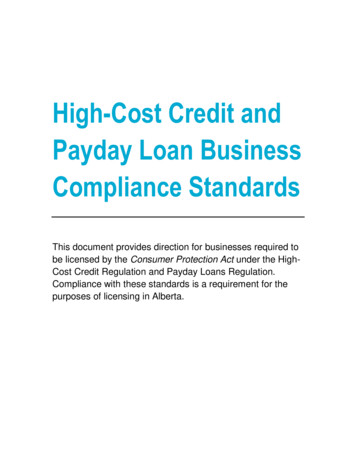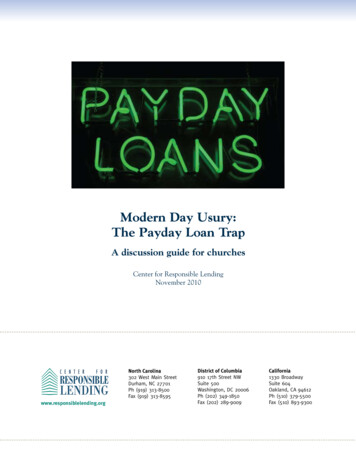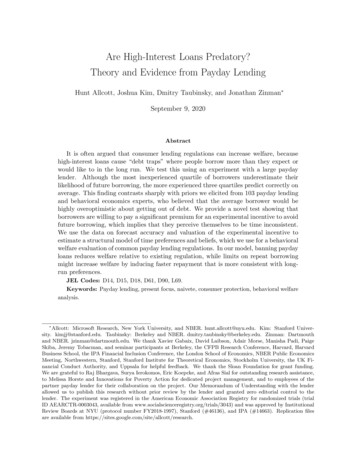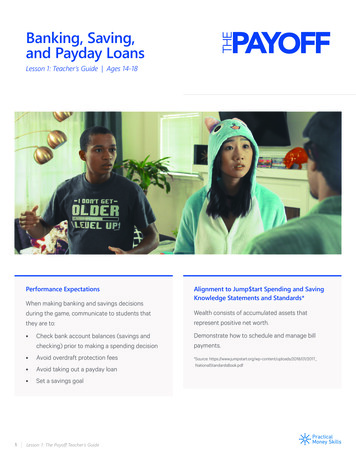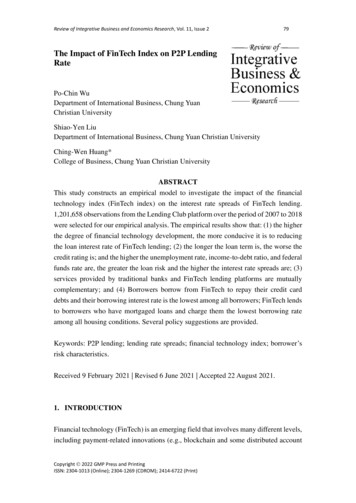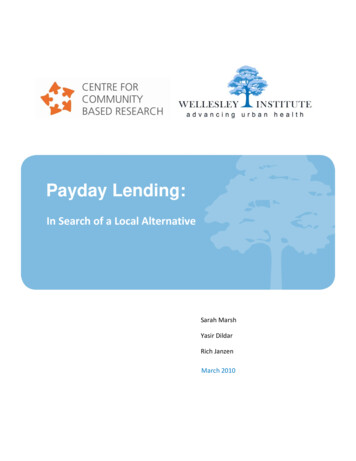
Transcription
Payday Lending:In Search of a Local AlternativeSarah MarshYasir DildarRich JanzenMarch 2010
Payday Lending: In Search of a Local AlternativeStudy Advisory CommitteeCentre for Community BasedResearch TeamNimira Lalani, Wellesley InstituteSarah Marsh, Centre ResearcherJulie Langham, Libro FinancialMary MacKeigan, Opportunities WaterlooRegionJoe Mancini, The Working CentreYasir Dildar, Centre ResearcherRich Janzen, Research DirectorBrian Barlett, Community ResearcherDave Pearson, Mosaic Family CounsellingNicole Wazir, Kitchener Downtown CommunityHealth CentreCentre for Community Based ResearchWellesley Institute73 King St. W. Suite 300Kitchener, Ontario N2G 1A7Tel: 519‐741‐1318 Fax: 519‐741‐826245 Charles St. E. Suite 101Toronto, ON M4Y 1S2Tel: 416‐972‐1010 Fax h.caThe Centre for Community Based Research isfocused on strengthening communitiesthrough social research.The Wellesley Institute advances urbanhealth through rigorous research, pragmaticpolicy solutions, social innovation, andcommunity action.This project was funded by the Wellesley Institute. The views and opinions expressed in the paper do notnecessarily reflect those of the Wellesley Institute.Payday Lending: In Search of a Local Alternative by Marsh, S., Dildar, Y. & Janzen, R.,March 2010, is licensed under a Creative Commons Attribution‐Noncommercial‐ShareAlike 2.5 Canada License.Media and Publications inquiries, please contact us by phone at 416‐972‐1010 or bye‐mail at contact@wellesleyinstitute.com.Payday Lending: In Search of a Local Alternative Centre for Community Based ResearchPage 2
Table of ContentsStudy Advisory Committee . 2Centre for Community Based Research Team . 2Executive Summary . 4Summary of Policy Recommendations . 5Introduction . 6Payday lending 101 . 6Payday lending in Canada . 7Overview of the study . 7Purpose and research questions . 8About the research partners . 8Research approach and methods . 8Study Findings . 12Income sources and income levels of payday loan borrowers . 12Borrowers’ motivations & satisfaction . 12Is there a need for a local alternative to payday lending? . 18What payday lending alternatives exist across North America and globally? . 20How should the need for an alternative to payday lending be approached locally? . 21Policy implications . 26Recommendations for next steps . 29Findings indicating need for further study outside the scope of our topic: . 29References . 30Appendix A: Payday Lending Alternatives Literature Review Summary. 32Appendix B: Payday Lending – Environmental Scan . 42Payday Lending: In Search of a Local Alternative Centre for Community Based ResearchPage 3
Executive SummaryThis report summarizes a small independent research study conducted to gain a deeper understandingof payday loans from multiple perspectives and to explore the need for a local alternative to paydaylending. A payday loan is a small short term loan guaranteed with a post‐dated cheque dated for theborrower's next payday (typically 100‐ 500 borrowed for approximately 10 days). Using WaterlooRegion as a case study, the Centre for Community Based Research conducted this study, in partnershipwith the Wellesley Institute and with guidance from an advisory committee. Using a Participatory ActionResearch approach, this study confirmed the need to develop a comprehensive local communitybanking project as a way to provide individuals with support and access to financial services, withbroader application for other jurisdictions.Key FindingsBorrowers’ incomes: Approximately 50% of borrowers surveyed work full‐time, and almost 25% receiveOntario Disability Support Program (ODSP).Borrowers’ motivations and satisfaction: Borrowers of payday loans usually use the money for essentialneeds and debt; people living on lower incomes (under 30,000) are more likely to borrow payday loans Borrowers are satisfied with the convenient location and hours and no minimum credit rating,as well as friendly, quick, non‐judgmental services Borrowers are dissatisfied with the high cost of borrowing, short payback period, lack of fulldisclosure about that high cost, stress associated with debt, and the collection practicesEvidence of need for an alternative: payday lending is a symptom of wider social problems includingchronic debt, poverty, etc. Overwhelming majority of key informants, borrowers interviewed and survey participantsindicated a need for an alternative to payday loan facilitiesViable model for a local alternative to payday lending: based on the research data, a holisticcomprehensive approach to a community banking project would work best in Waterloo Region, ratherthan an isolated payday loan alternative service. A literature review of existing payday lending alternatives revealed several models in NorthAmerica, Australia, and the U.K. One Canadian example, located in Winnipeg, takes a similarapproach to the holistic model suggested by the data.Recommendations for next steps1. Disseminate final research report using web‐based approaches, including social media & website2. Create a separate practical document for sharing Waterloo Region‐focused aspects3. Explore potential next steps for developing a collaborative microfinance project in Waterloo Region.a. Large community forumb. Small meeting of potential collaboratorsc. Engage with each stakeholder group: financial institutions; community organizations;potential funding sources; borrowers; governments4. Communicate policy recommendations to appropriate bodiesPayday Lending: In Search of a Local Alternative Centre for Community Based ResearchPage 4
Summary of Policy RecommendationsThe following summarizes a number of provincial and federal policy implications that emerged from thedata. These recommendations are further described in more detail in the main body of the report.Provincial policy area recommendationsENFORCEMENT: That the Ministry of Consumer Services demonstrate their enforcement of currentregulations under the Ontario Payday Loans Act with particular attention to: ENSURE that only registered lenders are supplying payday loans; ENSURE that all payday lenders have educational materials available on‐site IMPLEMENT the Ontario Payday Lending Education FundCONSUMER PROTECTION: That the Ministry of Consumer Services Consumer Protection Branch increaseefforts to ensure public awareness of interest rates for payday loans: FEATURE educational materials regarding payday loans on their website PROVIDE public service announcements in mainstream mediaFINANCIAL LITERACY: That financial literacy curriculum for youth and adults in Ontario include thelearning goal of increased awareness of payday lending, its high interest rates and short pay‐backperiods.POVERTY REDUCTION STRATEGY: That the Ministry of Children and Youth Services clarify to the publichow the Community Opportunities Fund is being spent. According to Ontario’s Poverty ReductionStrategy, 5 million is invested annually in a Community Opportunities Fund.Federal policy areasNATIONAL STRATEGY: That the Task Force on Financial Literacy explore microfinance incentivesincluding: Micro‐loan funding Asset‐building programs Credit restoration opportunitiesFINANCIAL SERVICES FOR PEOPLE WITH LOW‐INCOMES: That the Financial Consumer Agency of Canadaextend increased access to financial services for people with low‐incomes.Payday Lending: In Search of a Local Alternative Centre for Community Based ResearchPage 5
IntroductionThis report summarizes the findings of a research study conducted in Waterloo Region, Ontario by theCentre for Community Based Research (CCBR). The purpose of this research study was to look at thenature of existing payday lending services from multiple perspectives and to explore the need for andpossibility of a 'made‐in‐Waterloo Region' alternative to payday lending. The project idea was initiatedby staff at CCBR in consultation with community partners. Wellesley Institute(www.wellesleyinstitute.com) joined this partnership, carried out an environmental scan of national andinternational literature on payday lending (see Appendix), initiated connections with a local bank(Goodwill Industries, London, Ontario) and provided the funds to carry out the research.The report is intended for a diverse audience of individuals and organizations interested in the topic ofpayday lending and the potential to develop alternatives. It is meant to be a source of information ingeneral, and more specifically, it can be a launching pad for forming a local alternative communitybanking project. It is relevant to the financial sector, social services sector, public sector, as well asborrowers of payday loans, academics, activists, and educators. The report is structured so that it beginswith an overview of the payday lending industry, a description of the research study, and then a reportof the findings, which are organized according to the main research questions. The final section of thereport is recommendations for next steps.Payday lending 101A payday loan, also called a payday advance or pay cheque advance, is a small, short term unsecuredloan to meet the borrower's expenses until his or her next payday. The borrower guarantees repaymentwith a post‐dated cheque or pre‐authorized debit. Typically, the loan amount ranges from 100 to 400and it is usually due 10 to 14 days later. The average loan amount is 280 borrowed for a period of 10days (Canadian Payday Loan Association, 2009). Lenders typically require borrowers to prove threemonths of continuous employment, produce proof of address, and have an active chequing account. Nocredit cheque is performed. The interest rate charged is much higher than those charged by banks orcredit cards. The average loan interest rate can range from 390% – 780% APR (annual percentage ofrate) (Americans for Fairness in Lending, 2010), exorbitantly higher than the 60% anti‐usury clause in theCriminal Code of Canada.The proponents of payday lending, such as the Canadian Payday Loan Association, argue that paydayloan stores provide a service which is not available from other sources. They establish that many creditunions have attempted to offer similar products, with lower interest rates, but have been unable to doso without government grants or subsidies. A staff report released by the Federal Reserve Bank of NewYork concluded that payday loans should not be categorized as 'predatory' since they may improvehousehold welfare. Moreover, they further assert, that payday stores extend credit to 'risky' customerswith high chances of default.However, the critics, including the Public Interest Advocacy Centre, term this practice as exploitative,taking advantage of people's financial hardships. They say that low‐income borrowers are more likely tobe trapped in a 'debt cycle' because the short pay‐back period makes it difficult to pay back the entireamount owing. Statistics compiled by the Centre for Responsible Lending (2009) show that the majorityof the industry's profit comes from repeat borrowers who are unable to repay loans on the due date andinstead repeatedly borrow, paying fees each time.Payday Lending: In Search of a Local Alternative Centre for Community Based ResearchPage 6
Payday lending in CanadaStarting in the 1990s, payday loans became increasingly popular in Canada. In the same time period,traditional banks had begun tightening restrictions on lending small amounts of money (under 5000).Approximately 1,350 stores operate in Canada, with over 700 in Ontario (Robinson, 2006, p. 11). Over 40storefronts operate in Waterloo Region (population 533 700).The payday lending industry supplies short‐term credit in small amounts to meet the demand of peoplewho are not served by traditional banks. Ultimately, this trend in the financial sector encourages andfosters a two‐tiered banking system: at one level, we have a highly regulated service, strictly monitoredby the Financial Consumer Agency of Canada (Financial Consumer Agency, 2010) for the majority ofresidents, and at another level, we have a loosely (and very recently) regulated service, with unspecifiedmonitoring by provincial ministries offered at a vastly higher cost for those with limited resources orwho have a poor credit history.Up until 2007, payday lending was technically not legal in Canada, because fees exceeded anti‐usurylaw, but the industry flourished nevertheless. The government was aware of the issue and deliberatedhow to respond to this dilemma. Before any legislative changes, a class‐action law suit against one of thelargest providers of payday lenders was launched and settled out of court. In the spring of 2007, theCanadian government amended the anti‐usury section of the Criminal Code of Canada, section 347, toexempt payday lenders from the maximum 60 % Annual Percentage Rate and to give provinces andterritories the authority to implement regulations independently (Ministry of Government Services,2009). Since that time, Ontario’s Payday Loan Act was passed in 2008 and most elements wereimplemented during 2009 (Ministry of Consumer Services, 2010). The main elements of this Act are asfollows: Payday lenders and loan brokers are required to be licensed."Rollover" loans are prohibited.Payday loan borrowers have a two‐day "cooling off" period to cancel a loan with no reasonwithout incurring a penalty.An Ontario Payday Lending Education Fund will be established, paid for by licensees.Maximum total cost for borrowing a payday loan in Ontario is 21 per 100 borrowed.It is early yet to know how these regulations will affect the industry, but already these regulations areseen by critics as quite lenient. Some have speculated that increased, even stricter regulations will beneeded, since the industry representatives themselves are pleased with the current rules. The CanadianPayday Loan Association, a national body representing most of the established lenders in the industry,has been advocating for regulation of payday lending since they started.Overview of the studyPayday lending has been vastly under‐studied in Canada, with the exception of the area of fee structures(Robinson, 2007). The first national Statistics Canada study on the issue was the Survey of FinancialSecurity. It showed that "young families were three times more likely to have used payday loans" andthat "low‐income families (after tax) were fully twice as likely as those not in a low income bracket tohave used payday loans‐4.6% compared with 2.3%" (Pyper, 2007). This study is a start in understandingthe demographic information for who uses payday loans, but a gap remains in understanding why theyuse them, and what alternative would work for them.Payday Lending: In Search of a Local Alternative Centre for Community Based ResearchPage 7
Purpose and research questionsThe overall purpose of this research study was to look at the existing practice of payday lending and toexplore the need for a local solution as an alternative. Using Waterloo Region as a case study, six mainresearch questions were addressed by the study:1. What is the nature of borrowers’ experiences with payday lending?2. What are the motivations and levels of satisfaction of payday loan borrowers in the WaterlooRegion?3. Is there a need for an alternative to payday lending for low income people in Waterloo Region?4. What are existing alternatives to payday lending across North America and globally?5. Are there potential partner(s) interested to explore implementing a viable social enterpriseventure based on needs assessment?6. What are the policy implications of this study?About the research partnersTo understand the context of this research project, it is important to know a little bit about theorganizations behind it.Research teamThe Centre for Community Based Research (CCBR) is an independent, non‐profit organization focusedon strengthening communities through social research. CCBR believes in the power of knowledge toimpact positive social change. We are passionate about bringing people together to use knowledge toprovide real and innovative solutions to community needs. Our approach to research is participatoryand action‐oriented in a way that mobilizes people to participate as full and equal members of society. Itis in the spirit of our beliefs and passion that we conducted this research in partnership with theWellesley Institute. Project researchers were Sarah Marsh, Yasir Dildar, Rich Janzen, and Brian Barlett.Research partner and funderWellesley Institute (WI) is a Toronto‐based non‐profit and non‐partisan research and policy institutefocused on developing research and community‐based policy solutions to the problems of urban healthand health disparities. WI works in collaborations and partnerships locally, nationally and internationallyto support social and policy change to address the impact of the social determinants of health. Projectcontact and collaborators were Nimira Lalani and Michael Shapcott.Advisory CommitteeA six member advisory committee guided the research process. Committee members gave input into alldata collection tools, sampling criteria, participant recruitment, analysis interpretation, and thedissemination of findings. Members reflected diverse stakeholder groups including: social serviceagencies, an anti‐poverty initiative, a financial institution, and the partner organization: WellesleyInstitute.Research approach and methodsConsistent with other CCBR‐led studies, this research used a mixed‐methods participatory actionresearch (PAR) approach. The study was conducted by a four member research team, including anadvisor, two researchers, and a community researcher. Combined, these members bring contentexpertise (i.e. economic security), research expertise, and awareness of the local community context.Payday Lending: In Search of a Local Alternative Centre for Community Based ResearchPage 8
The project utilized several ways of gathering information involving different stakeholder perspectives.Use of a series of methods enhances triangulation of evaluation results and increases the rigour of thefindings. Main methods included:Payday Loan Borrowers Interviews: The research study explored the diverse motivations or reasons forusing payday loan facilities by conducting 11 individual interviews with selected loan borrowers. Theloan borrowers also provided their feedback about their level of satisfaction with existing services andsuggested key features of an alternative. Participants were recruited with posters located in communitylocations throughout the region, and selection was based on ensuring representation from Kitchener,Waterloo, and Cambridge, as well as gender and income source. All of the interviews were audio‐recorded and transcribed with participants’ permission.Interviewees represented three main urban areas of Waterloo Region: Kitchener, Waterloo, &Cambridge; both genders were represented (5 men; 6 women); the ages ranged from 20‐55 ; andsources of income included ODSP; full‐time work; and social assistance.Payday Loan Borrower Web Survey: A web‐based survey was conducted to capture a wider range ofborrower responses than could be gained through qualitative interviews regarding their motivations andlevels of satisfaction in borrowing payday loans and to learn about their perspectives on a potentialalternative. The survey was widely promoted to the public using web‐based social media, emails,posters, and a website with a view to reaching borrowers of payday loans in Waterloo Region, Toronto,and other parts of Ontario and Canada. Targeted groups included the advisory committee, partnercontacts at Wellesley Institute and CCBR, and service users at several community locations throughoutWaterloo Region.119 people started the survey and 76 completed it. All survey participants provided informed consentand no questions were mandatory, so some participants skipped a number of questions.Certain demographic information was gathered from respondents, including their age ranges and placeof residence. A broad range of ages was reported in the survey, the largest percentage being from the40‐55 years of age range. The percentage of borrowers in the 55 age group (17%) responding to thesurvey is considerably lower than the percentage of adults in that age group in Ontario (30%) (StatisticsCanada, 2006). The percentage of borrowers 40‐55 years old is somewhat higher than the generalpopulation, and the percentage of borrowers aged 20‐30 and 30‐40 are, to a small degree, higher thanthe general Ontario population of adults (Statistics Canada, 2006).43% of participants were from the Waterloo Region, 12% from Toronto, 33 % from other Ontario areas,and 12% of people either chose not to respond or they were from outside of the province.Payday Lending: In Search of a Local Alternative Centre for Community Based ResearchPage 9
Key informant interviews: Key informant interviews were conducted to learn if there is a need for alocal alternative, and to explore with potential partners the level of interest in the possibility ofimplementing a local initiative. A total of 10 key informants were identified in consultation with theAdvisory Committee to be interviewed. Selection criteria required that all participants be familiar withpayday lending and its impact in the community. Participants were selected to ensure a range ofinvolvement with this issue, a mix of individuals from within and outside of Waterloo Region, andrepresentatives from the following areas of expertise: financial services (n 3), human services, especiallythose dealing with economic security (n 4), academic or content experts (n 3), and funders withpotential interest in economic security (n 1). All of the interviews were audio‐recorded and transcribedwith participants’ permission.Literature Review: The first phase of the study included a comprehensive national and internationalreview of recent literature on payday lending. The focus was primarily on finding existing practices andalternatives to payday loans. Wellesley Institute also completed an Environmental Scan. Both thesummary of literature findings and the environmental scan are attached in the Appendix.Community Meeting: Toward the end of the study, diverse community stakeholders were invited to ameeting where they had opportunities to respond to and verify or clarify preliminary results, and toprovide insights to add to the study findings.Table: Research wCommunitymeetingDescription11 individual interviews were held with selected loanborrowers. Borrower motivations, satisfactions, andopinions about alternatives were addressed in thismethod.A web survey was open to the public during January2010. This method addressed the research questionsabout borrower motivations, satisfactions, andopinions about alternatives.Face‐to‐face and telephone interviews were heldwith key informants using a semi‐structuredinterview protocol. The primary research questionsaddressed were about alternatives and potentialpartners for a payday lending alternative and policyimplications.A national and international recent literature onpayday lending was reviewed. The focus wasprimarily on finding documentation of existingpractices and alternatives to payday loans as well aspolicy implications.Preliminary results were shared at a meeting of 30diverse community stakeholders. Through small andlarge group discussions, meeting participantscontributed verification of preliminary findings andadditional valuable insights to the study.InvolvementPayday loan borrowers(n 11)Individuals who hadborrowing experience and/orknowledge of payday lending(n 76)Individuals from a range ofsettings, including: financialinstitutions; community non‐profits; government;academic (n 10)Wellesley Institute literaturereview contributions;academic articles; reports;contributions to paydaylending listserv.30 interested communitymembers, including outreachworkers, business owners,individuals from communitynon‐profit organizations,foundations, and financialinstitutions, among others.Payday Lending: In Search of a Local Alternative Centre for Community Based ResearchPage 10
Data analysisData analysis was carried out collaboratively by the research team to ensure that study themes wereidentified and confirmed by multiple team members. Furthermore, research findings were presented tothe advisory committee for further verification. The web survey data was analyzed through graphs(using MS Excel) while the qualitative data from key informant interviews and individual interviews wastranscribed and analyzed using content analysis based on five main research questions.LimitationsIt is important to highlight the fact that the web survey results are not representative of all payday loanborrowers. The survey was not based on a random sample and the sample size was relatively small, sowe cannot generalize the study findings for mainstream payday loan borrowers.Study scopeThe focus of this study is on existing payday lending practices and the potential for an alternative, whichare particular aspects of the wider dilemma of lack of access to financial services for vulnerable and low‐income populations. While the scope of our inquiry did not extend to most aspects of financial exclusionfor low income and marginalized people (for example the unbanked), all data sources (interviewees,survey participants, documents, community meeting participants) were interested in payday lending asjust one piece of a larger puzzle including the lack of access to financial services for many in Canada andthe need for increased knowledge and skills in managing personal finances.Payday Lending: In Search of a Local Alternative Centre for Community Based ResearchPage 11
Study FindingsThe study findings are summarized in six sections. The first is a brief look at the nature of borrowers’incomes. The rest of the five sections mirror the main research questions: existing practices; borrowers’motivations and satisfaction; the need for an alternative; existing alternatives; developing a localapproach to alternatives; and policy recommendations.Income sources and income levels of payday loan borrowersInsights about the income sources of people who borrow payday loans were gained through all datasources, including the anonymous online survey for borrowers. Survey respondents varied in source ofincome; approximately half (49%) work full time and almost a quarter (22%) receive Ontario DisabilitySupport Program (ODSP). Canadian citizens make up 89% of survey participants, while the other 11% arepermanent residents. The majority of participants are living in single adult or two‐adult households.According to Stegman and Faris (2003), households with annual incomes under 50,000 make up the‘core market’ for payday loans. Results from the Canadian Ipsos‐Reid Express (Ipsos‐Reid, 2005) – anational omnibus poll of Canadian adults indicated that households with incomes less than 30,000 peryear were more likely to have borrowed a payday loan (2005).While the typical income levels of payday loan borrowers are modest to low, some borrowers arehomeowners and people with high‐income levels.“I belong to a credit union. I have a lot of equity in my house. I needed a small amount of moneybut they would not comply because of my poor credit rating. As such, I got the money frompayday loan.” (Borrower interviewee)“I have excellent credit rating but RBC [Royal Bank of
Borrowers of payday loans usually use the money for essential needs and debt; people living on lower incomes (under 30,000) are more likely to borrow payday loans Borrowers are satisfied with the convenient location and hours and no minimum credit rating,
